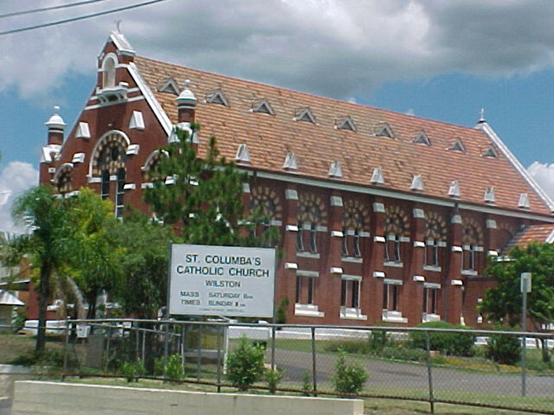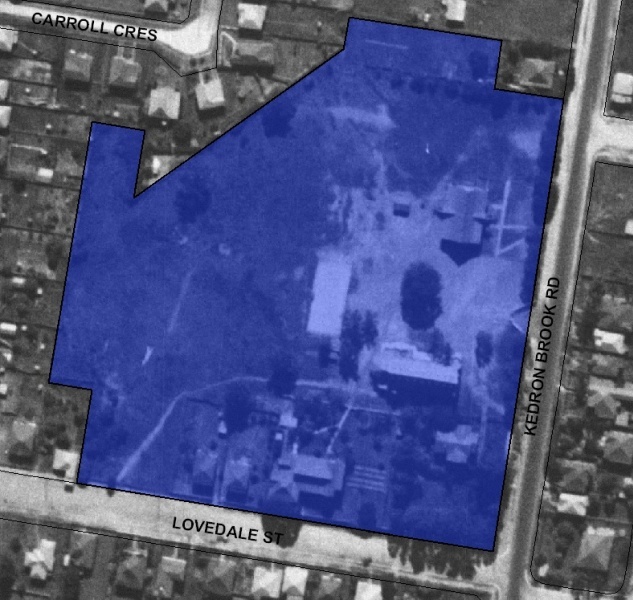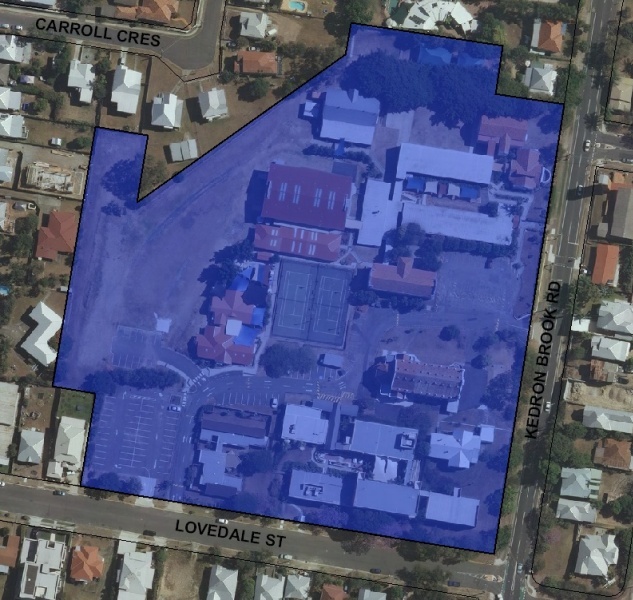Addresses
Type of place
Hall, Private school
Period
Postwar 1945-1960, World War I 1914-1918
Style
Romanesque
Addresses
Type of place
Hall, Private school
Period
Postwar 1945-1960, World War I 1914-1918
Style
Romanesque
St. Columba’s Church, which was designed by prominent Brisbane architect G.H.M. Addison and opened in 1915, was the first building to be constructed on this site. Over the next few years, the site developed into a centre of Catholic worship and education for the local community through the construction of a school and convent in 1917, and a presbytery in 1921. The upper storey of the school building has since been removed to a different part of the site for use as a parish hall and the convent was later demolished. Due to alterations to the original fabric, the presbytery retains no heritage significance. In 1949, a new secondary school for girls was constructed and is still retained within the school grounds as ‘Our Lady’s Block’. The three buildings still operate as a church, hall and school today.
Lot plan
L1_RP168492
Key dates
Local Heritage Place Since —
Date of Citation —
People/associations
George Henry Male Addison - church and school (Architect)Criterion for listing
(A) Historical; (E) Aesthetic; (G) Social; (H) Historical associationInteractive mapping
Lot plan
L1_RP168492
Key dates
Local Heritage Place Since —
Date of Citation —
People/associations
George Henry Male Addison - church and school (Architect)Criterion for listing
(A) Historical; (E) Aesthetic; (G) Social; (H) Historical associationInteractive mapping
History
St. Columba’s Church is the first in a series of churches designed by architect G.H.M. Addison for the Catholic Church. It was built shortly after the opening of St. Brigid’s Church at Red Hill that signified a new brick building phase in the archdiocese of Brisbane. Other Catholic churches designed by Addison include St Benedict’s at East Brisbane (1917), Sacred Heart, Rosalie (1918) and St Oliver Plunkett at Cannon Hill (1921). St. Columba’s is similar in appearance to the other Addison churches, all of which are predominantly Romanesque in style. St Columba’s was dedicated on 3 January 1915. It was the first Catholic church to be built in this style which would predominate during Duhig’s early period of church building.
St Columba’s was built during World War I, a time of rapid development for the Wilston area, then a part of Windsor Shire. The opening of the railway line to Enoggera in 1899 had spurred residential development in the surrounding suburbs. Wilston station, which opened in 1899 as a ‘gate’ station, was converted to an island platform during the 1920s. The extension of the tramline to Windsor in 1914 and along Maygar Road to the Grange in 1928 made the Wilston area even more accessible from the city. The population growth in the area in the years of World War I is indicated by the need to establish a new school to accommodate the growing number of children. The Wilston State School opened in 1920 with an enrolment of 396 pupils. With such a rapid growth in population, it was not long before the increasing number of Catholics in Wilston desired a church in their locality.
The Wilston district was originally in the parish of St Patrick’s Church of Fortitude Valley. After 1886, the nearest Catholic Church was Holy Cross at Wooloowin, which obtained a resident priest in 1892. The first moves to establish a church in the Wilston district were initiated before World War I by a local resident, Mr Hurley, and Monsignor Byrne, the administrator of the cathedral, who brought the need for a church to the attention of the Archbishop.
On the recommendation of Mr Hurley, Archbishop Duhig purchased an acre of land for 100 on Kedron Brook Road. Duhig subsequently bought the adjoining three acre site for 300. As with so many church sites chosen by Duhig, the property was situated on a hilltop with a fine view. On 10 May 1914, a meeting of local Catholics, attended by Archbishop Duhig, was held at the home of Mr Hurley and a resolution passed unanimously to build a brick church. A sum of 620 was collected at the meeting towards the cost of establishing a church, including a large donation from one individual. Another parcel of land containing the site of the future church was purchased for 800 the following month. This property included a house in which mass was celebrated for several months prior to the erection of the church. The contract price for the new church was £2 064. Funds for the church’s construction were raised through donation and fundraising events.
St Columba’s was one of the earliest churches to be built during Duhig’s intensive brick building period. The foundation stone was laid on 23 August 1914, only one week after the opening of St Brigid’s at Red Hill. The ceremony was significant in the history of the Catholic Church as two Coadjutor Bishops, Mannix and Duhig, joined hands and laid the stone together. On 3 January 1915, St Columba’s was blessed and opened. Mass was celebrated in the church by Father Barry of St Patrick’s until his departure for the war in 1916. He was replaced by Father H.A. Fitzgerald, the first resident priest of St. Columba’s, which became a separate parish in 1916.
After the opening of the new church, the land fronting Lovedale Street was purchased by Duhig. In keeping with the Catholic church’s commitment to religious education for its children, a school was soon established under the Sisters of the Good Samaritan, an Australian order. The school and a convent, also designed by Addison, were opened in 1917 followed by the Californian Bungalow style presbytery on the city side of the church in 1921. The presbytery has been substantially altered and is not being included as a building of heritage significance in this citation.
The upper storey of the first school building has been moved from its original site to behind the newer school complex where it serves as the parish hall. The hall, which has a stage at the western end, is also used by the school for school activities and after school care. A brick extension has been added on the southern side of the building.
The original convent has been demolished and replaced with a modern convent building. The 1921 presbytery remains on the site and has had some additions. In 1949, a secondary school for girls which featured a domestic science room was established in a new stucco and tile building now known as Our Lady’s Block. The original wall tiles, laminex benchtops and cupboards have been retained along one wall of the downstairs classroom which was once the domestic science room.
A new primary school building with offices was opened in 1964. This forms the main entrance for the primary school. During the 1970s, the secondary school was renamed St Benedict’s College and a new building was opened in Lovedale Street. St Benedict’s closed during the early 1990s. The college building is now used as the Father Bernard (Bill) O’Shea Inservice Centre. Father O’Shea left the parish in April 2002 after serving as the Parish Priest for some 13 years.
The original acre of land purchased by Duhig developed in only a couple of years into a large Catholic precinct of 8 acres that would become a focus for Catholic worship and education in the local community into the 1990s. By the mid-1930s, during the years of the Great Depression, the church was overflowing due to the population growth of the area. Extensions to the church, designed by Frank Cullen, were carried out in 1936 at a cost of approximately £4000, demonstrating the commitment of the Catholic community to continuing to meet the needs of parishioners.
St. Columba’s remains an important presence in the suburb of Wilston, both as a notable landmark and a valued part of the local community. Events such as the biennial fete are well attended.
Description
St. Columba’s is an impressive polychromatic brick church. Federation Romanesque in style, the building has a steeply pitched, tiled gable roof and round arched openings. Situated between associated administrative and school buildings, it sits in a prominent position on a hilltop above Kedron Brook Road.
A traditional latin cross in plan, the church consists of a large nave, two small transept chapels, vestries and a semi-octagonal apse. Later additions include a baptistry to the front north east corner of the nave, and confessionals linked to each chapel. Entry to the nave can be made via the chapels or through entry doors in the front façade and sidewall opposite the baptistery. Disabled access is provided to one of the chapels.
White, rendered horizontal bands, plinth, coppings, window heads, sills and other mouldings provide contrasting decoration to the largely red brick exterior walls. Divided into bays by stepped buttresses, six of the nine side wall bays of the nave feature stained glass windows. The buttresses which pierce the roof above the eaves line, have rendered triangular cappings.
Within each side wall bay, two tier, coupled lancet windows sit below a decorative brick panel which encompasses a central circular window. Farmed by a large dichromatic arch, this panel incorporates smaller arches over each upper lancet window head and a circular window surround. both constitute the same brick colours as the larger arch. The remaining wall area of this decorative panel is infilled with blue/grey bricks.
The large gable roof of the nave has triangular vents within each structural bay and parapet walls to each gable end. Lower gable roofs over the chapels have parapet walls to their eaves and gable ends. Horizontal parapet walls form the perimeter of the vestries, confessionals and baptistry concealing their roofs. The walls of the baptistery and confessionals are capped with blue/grey bricks. The steeply pitched hipped roof of the apse is surrounded by a lower verandah roof which links the two vestries. A carport style skillion roof structure has been placed over the nave side entry door at a later date.
The symmetrical front façade of the building has a pinnacle to each corner and a cantilevered aedicule within its apex. Divided into three bays by buttresses, the outer bays are identical to the side wall bays, but with more ornate mouldings. The central bay has larger windows above a lower parapet gable wall, set flush with the buttresses. A pair of large timber doors with a glazed fanlight sit within a deep arched opening. Flanked by a small window to each side, the door is accessed via a short flight of terrazzo steps.
The parapet gable walls of the side entry and chapels feature a central arched opening comprising a pair of timber doors and a rendered fanlight. These are framed by a dichromatic and white moulded arch springing from a moulded impost course. A small window sits to either side of the chapel doors. All the windows of the building have metal frames: most are casements. Apart from the upper tier windows of the nave, the remaining windows of the nave, baptistery, chapels and vestries are rectangular. Two tier stained glass windows in the apse feature upper tier arched heads.
The high spacious nave of the building has a rendered concrete floor with carpet to the aisles and sanctuary. Large hammer beam trusses, which rest on moulded corbels, support a timber panelled ceiling. A timber cornice with quatrefoil designs runs between each truss, above the rendered masonry walls. At the western end of the nave a large moulded arch frames the sanctuary. Two raised platforms are reached by marble steps and terrazzo floor panels. Smaller arches separate the chapels from the nave. Each chapel has a terrazzo and marble alter. Their ceilings comprise timber panelling whilst the apse ceiling is rendered.
To the eastern end of the nave, a timber choir gallery is accessed by a narrow flight of stairs. Between its central supports, a louvred glass screen and planter box have been added. To each side wall of the nave, timber panels between each window feature the stations of the cross. Later additions of fans and speakers are not intrusive, however, lights mounted on the walls are out of keeping.
The development of St. Columba’s has involved various extensions. Slight changes in brick and tile colour indicate that the last three bays of the nave have been added later. The last two bays have blind arches above the transepts. the chapels, vestries and apse were added later again. More recent extensions include the confessionals which have incorporated a window to each side of the nave, and baptistry built out of an original entry door. All the extensions are in keeping with the character of the building except for the carport style roof over the nave side entry door.
Statement of significance
Relevant assessment criteria
This is a place of local heritage significance and meets one or more of the local heritage criteria under the Heritage planning scheme policy of the Brisbane City Plan 2014. It is significant because:
References
-
Age (Brisbane). 29 August 1914, 11 April 1929
-
Brisbane Catholic Archives. Wilston Parish File
-
Brisbane Centenary Celebrations Committee 1924, Brisbane Centenary Official Historical Souvenir, Brisbane
-
Catholic Leader. 12 March 1936, 1 July 1992
-
Ferrier, P. 1986, The Golden Period of Catholic Progress: Archdiocese of Brisbane 1912-1927, B.Arch. thesis, University of Queensland
-
Mennis, Mary. The History of the Parish and School of St. Columba’s, Wilston, Brisbane 2000. Manuscript, copy held at BCC Heritage Unit
-
O'Leary, Rev J. 1919, Catholic Progress: Archdiocese of Brisbane 1912-1919,J. O'Leary, St James' Presbytery, Coorparoo
-
Information kindly provided by Sr Ann Marie Nicholls, Principal, during a site visit 11 April 2002
Citation prepared by — Brisbane City Council (page revised September 2020)



